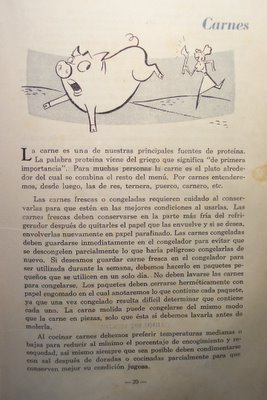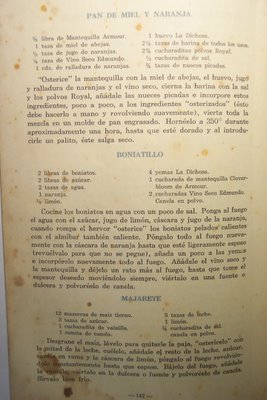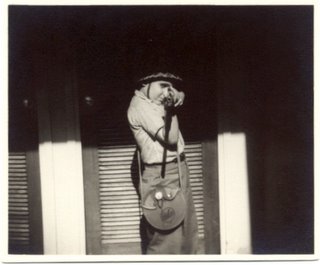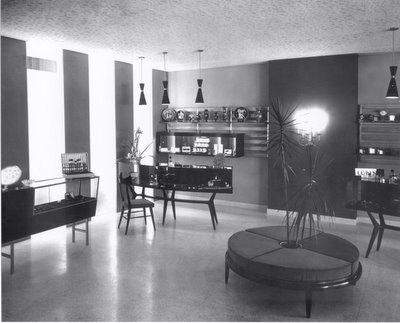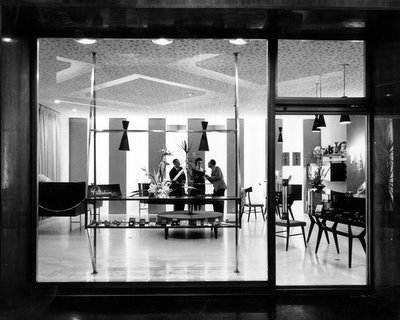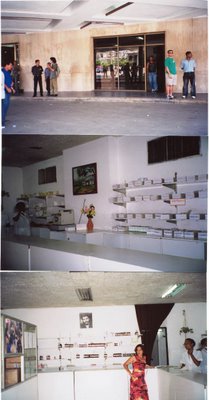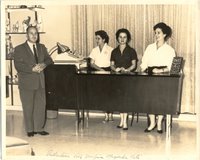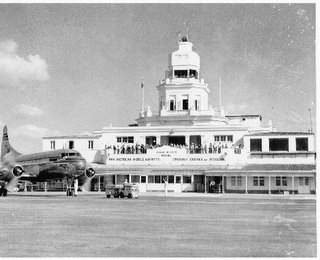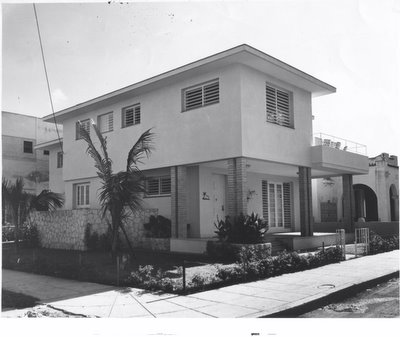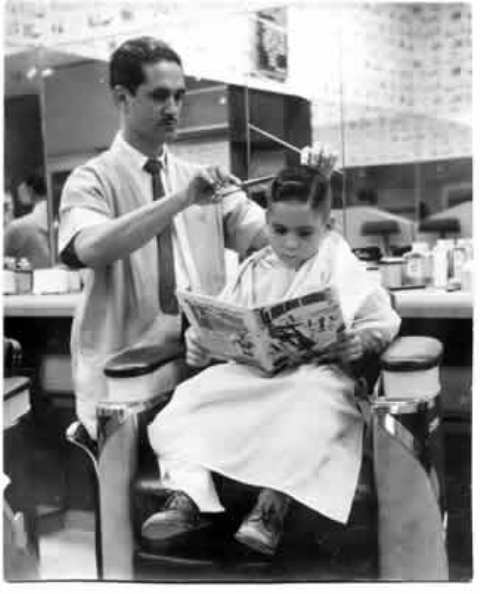
"Well, there you go again..." As good ol' President Reagan would have said - because again, am violating my own "chronological order rule." But another 45th anniversary has crept up on us. Today marks 45 years we arrived in Miami, F-L-A. And we've been Floridians ever since. Not that we weren't somewhat familiar with our beloved Sunshine State already, as we had vacationed in "la Florida" in the 50's.
Had a chance to rummage through the Quiroga-vault today, and dug up my Cuban passport, which tells its own tale through the stamps of the bureaucracies and related powers-that-be, found throughout its pages.
I promised to explain why we left Havana for Aruba instead of, logically, for Miami or other destination in the USA. It goes like this. Due to our frequent travels to the USA, we already had tourist visas issued by the US Department of State, which were good until 1961.
Starting after January 1960, and accelerating through the spring and summer of that year, Cubans started lining up outside the United States embassy, many desperately seeking visas to the 'States. Let's just say the "revolutionary atmosphere" was starting to feel choking and oppresive to many Habaneros, and others throughout the island. We were able to see the snaking lines of people from our perch at the Focsa building, as the embassy was within walking distance from the building.
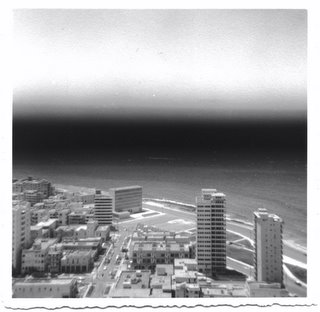
The photograph of the United States embassy was taken by father from the Focsa building sometime in 1957-1958, with his trusty Kodak 35mm camera-he enjoyed photography, for which we are grateful. Otherwise, we would not have these images. Notice there were no lines of desperate people looking for visas, in those pre-1959 days. The embassy is the rectangular building almost all the way to the shore line, by the Malecon, or seawall.
Since we already had tourist visas, no sweat, thought mom and dad - we can get on a plane, fly to Miami, and then do what needs to be done in order to stay. Stay until the "revolutionaries" leave, or, more realistically, are kicked out. My mother was getting anxious about leaving, more so when the rumors started making the rounds, that the (mis)government was going to take over the entire educational system, public and private, and, worse, take away parents' rights over their children. That was referred to as "perder (lose) la patria potestad" over one's child.
On January 28, 1960 dad went with our passports to the US embassy, in order to explain we were thinking of going to the United States for a while, and ask what needed to be done on our part so that everything would be in order. "Oh, so I suppose what you really want to do is emigrate to the United States,?" he was asked by Consul Benjamin F. Houck. Dad, being a straightforward, honest type, answered something like "Well, I suppose so; you could say that." Whereupon good Consul Houck, before dad could react, grabbed the passports, and thumpingly stamped each tourist visa with a big, black "CANCELLED" stamp. He then looked up at dad and said, I gather in a nonchalant way, "We'll put in paperwork to have immigrant visas issued." Of course, dad was pleased as punch to find out this process might take MONTHS. Meantime, things would continue to deteriorate between the United States and Cuba - as they did - and we might wind up trapped between a "revolutionary" rock and Consul Houck's hard ass.

Question to you, Consul Houck, sir: Why did you do this? Were you a closet "barbudo" sympathizer? Or were you afraid we were going to Miami to become deadbeats and live off Uncle Sam's largesse? Or did you lose your ability to think straight after thumping passports with your "CANCELED" stamp for too many years? By now, only God knows the answers to these questions.
Needless to say, my mother was apoplectic about all this. She said to dad: "When it comes time to leave, I want to leave, as quickly as possible, no matter where to, or what it takes!" And so, as the winter melted into spring, and spring sprung into summer, and the "revolutionaries" got crazier and crazier vis a vis Uncle Sam, the level of desperation in our household increased. Of course, this I learned later. Mom and dad, at the time, and understandably, kept much of this from lil' sis and I.
This much I remember: I could not understand why the babbling, ranting man with the beard wanted to pick a fight with the Americans. Americans, as far as I was concerned, were A-OK people. What's with being friends with all these creepy looking Russians, anyway?
Dad kept trying to figure out which way we could exit this bad movie before it was too late. The rumors about the loss of parental rights kept increasing, and my mother insisted we all had to leave together. Finally, they found that Cuban nationals could fly to Aruba as visitors, NO VISA REQUIRED. Eureka! That was the answer. Because, at that late date, and this was already October, out of good Consul Houck's mahogany desk had come - nothing...
So, off to Aruba on November 10, 1960. And here is where I correct myself because, as the header for this blog states, "errors are the responsibility of the blog author and will be cheerfully corrected upon submission of valid and relevant evidence." Earlier I had written that we had flown out of Havana on Cubana Airlines. No! Nyet!
Nein! We actually flew good ol'Pan American World Airways (remember them?), the tickets being purchased by dad, on the 30th of September 1960, at Velasco Travel Bureau, formerly located at Plaza de la Catedral, Habana, Cuba. Now no more. I told you the stamps on the passports told the story. So, PAA flew us to Aruba - not KLM. KLM did fly us from Aruba to Miami.

In Aruba, we had the fortune - God looks after his own, I suppose - of dealing with American Vice Consul Richard S. Thompson and his beautiful, blonde secretary (funny how a 10 and-a-half year old started noticing...girls...we're supposed to hate them at that age, no?); mom and dad explained why we had come to be in Aruba and why we needed their help. I recall that the pretty blonde lady spoke fluent Spanish, and spoke at length with mother, who filled her in about all the doings and goings on of the man with the beard and his rude, screeching followers.
Whatever it was, whether the Vice Consul and his secretary felt pity for us, or felt bad about what good Consul Houck had done in Havana, on November 15, 1960 he issued us nonimmigrant visas so that we could go to the United States "on vacation," as he put it. No doubt he winked when he said that. God bless you, Vice Consul Richard S. Thompson-the AntiHouck. God bless you too, beautiful blonde lady - wish I remembered your name.

The required tickets were bought for our flight to Miami on November 19, via KLM Airlines. Mom and dad, having breathed a sigh of relief after obtaining the visas, decided we should loosen up a bit and enjoy the rest of our time in Aruba. I cannot emphasize enough that the people of Aruba were quite kind and hospitable towards us, and helpful throughout. One example was the attitude of the owner/manager of the hotel where we stayed, Hotel Strand. At first, when it looked as if we might be stranded (no pun intended) in Aruba for a while, dad worried about being able to pay the hotel bill. The rate was $25 USD daily. It seems ridiculously cheap now, but in 1960 that was not so cheap, when you consider that the newest hotel on the island then, a Sheraton, was going for $42 USD daily - and that seemed a fortune to us! You see, Aruba was on the expensive side because of the high cost of providing fresh water to the island through de-salinization. There were no fresh water wells, although Aruba did boast a working oil refinery. Getting back on track, dad asked the owner or manager of the hotel, who I believe was Chinese, "if he might consider giving us a break on the room rate," explaining the situation we faced. The owner said he would consider it, but had to talk to his wife, who obviously had a say-so in the matter. Well, in no time he came back to tell mom and dad it would be no problem to grant a reduction if it became necessary. But, in the end it was not necessary. God bless this nice couple for their consideration and kindness, at a time when these were in short supply on the other island we had just left...
Dad decided we should get to know Aruba a little bit, since we would not be there long. He hired a combination tour guide/chauffeur, a Mr. Moreno, whom I recall as a dapper man, in suit, tie, and fedora, cigar in hand. A good tour guide he was, driving us around the island, describing landmarks and telling us about Aruba's charms and peculiarities, such as the twisted divi-divi trees. He drove a beautiful, green 1959 Cadillac - Fleetwood? Sedan DeVille? I don't know anymore. I do know that when dad complimented him by telling Mr. Moreno "I think you have the most beautiful car on the island!," Mr. Moreno beamed and glowed, and, sounding very pleased, answered the compliment with "Gracias, gracias!" No, Mr. Moreno - gracias a usted. Thank you for showing us your beautiful Aruba, for your courtesy and professionalism,for the pleasure of your company-and, yes, to this day, I think you had the most beautiful car in Aruba in November 1960.
One last memory of Aruba, before this post is closed. At the Hotel Strand lobby, there was a TV set, and most nights we would drift to the lobby after supper, to catch the doin's on the boob tube. There was a comedy show from Venezuela, the name of the show lost to memory. The show might have been broadcast nightly, or perhaps 2-3 times a week; again, memory fails. I do recall the sponsor was Parliament Cigarettes - yes, it was legal to advertise lung torpedoes on the telly in 1960. And may as well mention the memorable - to me - Heineken beer commercials, featuring animated puppets, with a catchy tune that went something like "Heine-heine-Heineken, heine-heine-Heineken, heine-heine-Heineken!" Followed by a jingle in Dutch as the little gentleman and lady puppets enjoyed their beer. Don't worry, these black and white commercials did not warp me. I never smoked, and drink with discipline. Do enjoy an occassional Heineken, however.
Let's get back to the show after a word from our sponsors. The main character was a Venezuelan comedian named Amador Bendayan, who, with his Cuban sidekick, nicknamed "El Jiniguano (and please don't ask me the meaning of "Jiniguano" - I have no earthly idea, but perhaps a reader will enlighten us later)," entertained us with antics and situations which made us smile and laugh. Mr. Bendayan; Mr. Jiniguano, wherever you are-God bless you two, too. You brought us the gifts of humor and laughter at a time when we badly needed them. And that is why we do not forget.
